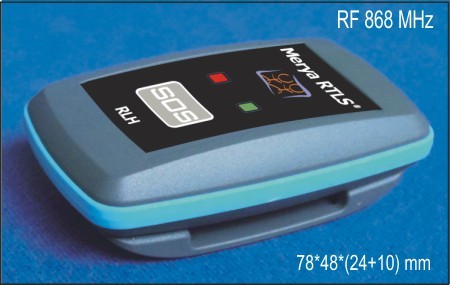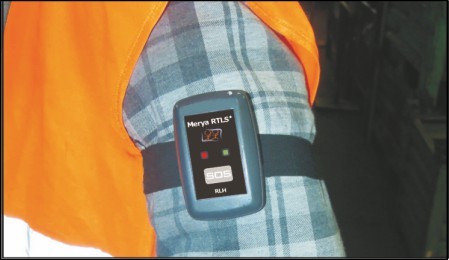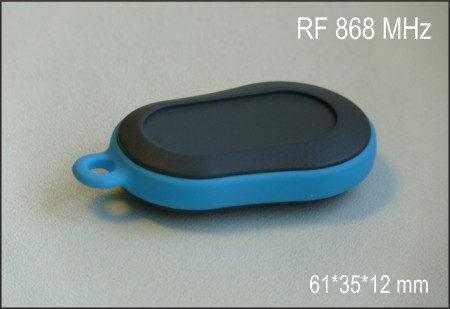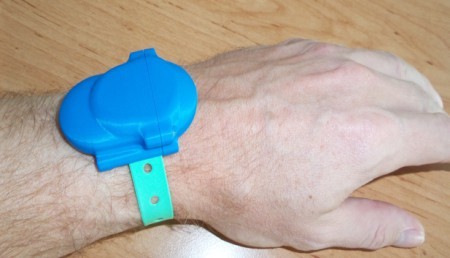Моніторинг RTLS за допомогою тегів RFID.
Merya RTLS - RFID
Merya RTLS is a wireless system for monitoring persons working predominantly at high-risk workplaces, using intelligent RFID tags and detectors. Transmission frequency is 868 MHz. The technology is used for determining the position of persons in real time (RTLS), in form of 2D/3D visualization on map basis in form of labels with corresponding names. The personal tags have built-in sensors for detection of lying person, immobility (loss of consciousness, etc.), freefall, or a call for help (SOS button). The monitoring can be done in individual areas of the object (building) and also outside it. The Merya RTLS also enables detection and signalization of person that remains in dangerous area. The batteries in detectors are user-replaceable. The Merya RTLS system can communicate with all types of IAS. In case of alarm situation, it is possible to guide PTZ cameras at the position of the corresponding detector. The outputs of Merya RTLS system can be integrated to superstructure surveillance systems, using SNMP-2 protocol. Each implementation is preceded by thorough measurements of radio signal in a given object, or area. Based on this measurement and an accuracy requirement for monitoring, it is then determined the position and the number of receiving detectors. The system requires no computer or software at the installation site. All modules work as embedded. This fact guarantees very high stability and independent functioning of the entire system!

Each RLH-06b tag has its own unique ID number, which is assigned to a particular person. The RLH-06b personal tag detects, after a user-configured timeout, a lying person (even in case the person is moving), immobility of a person (in case of loss of consciousness, etc.), or a freefall from a height of at least 3 meters. The RLH-06b tag has a built-in vibration motor for interactive communication with user, and an emergency SOS button. The radio range of RLH-06b tag is max. 50 m from the RLS detector at direct visibility, and max 100-150 m in case of using high-gain omnidirectional UMTS antenna. The tag uses two 1.5 V AAA batteries, which are user-replaceable. The tag is always worn in the vertical position. It can be worn on the arm (fig. 3), hunged on a belt, or placed in a special pocket of work suit.



The RLK-06 personal tag detects, after a user-configured timeout, an immobility of a person (in case of loss of consciousness, etc.), or a fre fall from a height at least 3 meters. The radio range of RLH-06b tag is max. 40 m from the RLS detector, at direct visibility, and max 120 m in case of using high-gain omnidirectional UMTS antenna. The battery lifetime is up to 250 days, at a transmit period of 3 seconds. If a power-save mode is activated, the battery's lifetime is longer. The tag is worn on the neck, or placed in a special pocket of work suit.

The RLK-06n personal tag is worn attached to the wrist by the vinyl strip with security fastening (see fig. 9), or velcro fastening. The strap is threaded through RLK-06n tag and fastened on the wrist. The tag is waterproof, and allows showering or bathing. The battery is replaceable. The battery lifetime is up to 250 days at the transmit period of 3 seconds. If power-saving mode is activated, the battery lifetime is longer. The radio range is about 30 m from the RLS detector, at direct visibility. In case that RLS detector has an external high-gain antenna, the range is about 70-120 m.

The Merya RTLS system is suitable for use at hazardous workplaces, e.g. ironworks, foundries, chemical plants, hardening, refrigeration plants, and the like, or the night "single-operation". The RLS detectors can be placed at the workplace, directly on the machine, or it can be placed in areas where detection and localization of persons is desired. Alarm and state information from the personal tags are periodically transmitted in real time via RLS detectors into the RLU central unit. In the case of crisis event, the RLU unit triggers the alarm scenario. Operational and alarm records are stored in the unit's memory. The unit has an internal memory for 20 000 events which can be continuously downloaded to a computer's database. A remote surveillance of the system and of all the collected data, can be realized via common web browser, within LAN network or the Internet. The Merya RTLS software enables an online displaying of a position and a state of persons, using graphical 3D visualization. The software uses ground plans of individual floors (in PNG format). The ground plans can be also used for visualization of position of persons that are nearby buildings, which have RLS detectors installed in their vicinity.

Tags nonstop periodically communicate with RLU central unit. System can indicate online a fault state, in which the tags aren't able to regularly communicate with the central unit. This ensures high reliability of the system. The surveillance of entire system and a state of all monitored persons can be carried via common web browser, within LAN network, or the Internet. The Merya RTLS software enables to display an online position of guarded persons, using 3D graphic visualization. Records of the above mentioned alarm situations, and also records of authorized or unauthorized stay of the person in individual areas, are stored in the RLU central unit's memory.
In case of need to monitor the presence of persons in an enclosed area (but no security guarding), the so-called "shell monitoring" will suffice for the solution. In this case, the RLS detectors are placed at both sides of doors, gates, entrances, etc., according to figure 13. The RLU central unit evaluates gathered information based on which it determines, whether the respective personal tag is located in given area or not, even in case that the tag is already outside of the system's radio range. This method of detection can be freely combined with a basic method of detection of RLS detectors that are placed at key locations inside the hall.

The basic principle of the system is definition of user areas around individual RLS detectors. The range of individual areas (X1-X3) is user-configurable in SW, individually for each detector (figure 16-18, green circle). This ensures large variability in the Merya RTLS system. Then, it is possible to configure the authorization to individual personal tags for each area - whether they may or may not stay in these areas, including the possibility of detection and indication of alarm events in these areas. The detector can receive security alarm messages from tags in the radio range determined by the type of antenna (fig. 16-18, gray circle). In case of alarm situation, this information is indicated localy at RLS detector's outputs, centraly in RLU unit, or in superstructure surveillance systems, with which RLU directly communicate.


